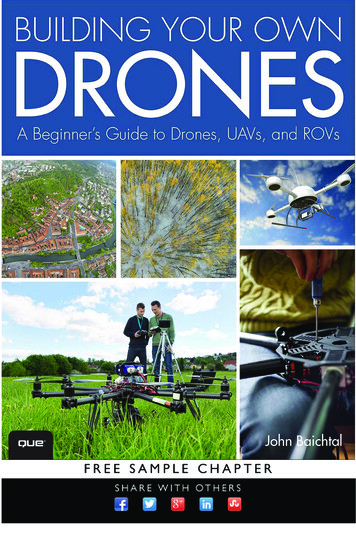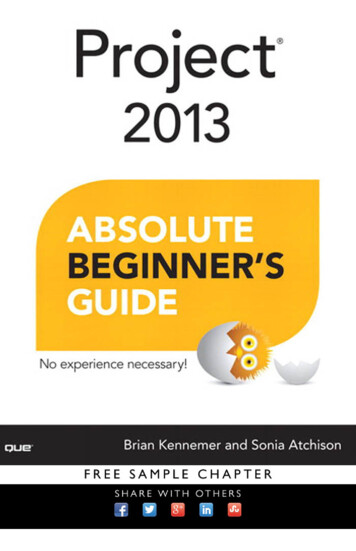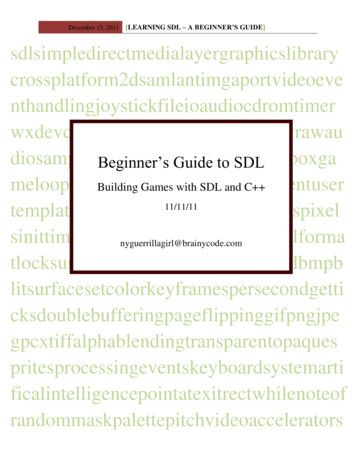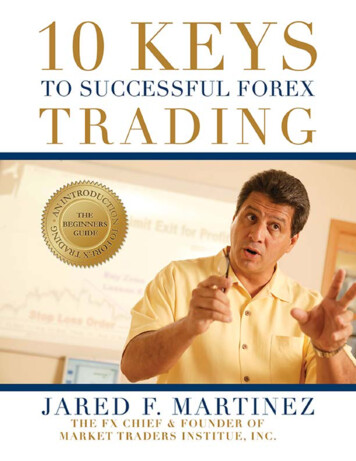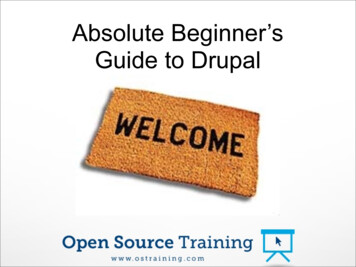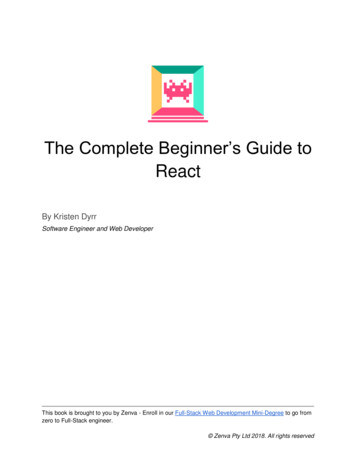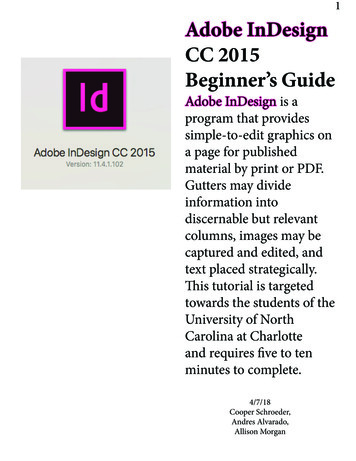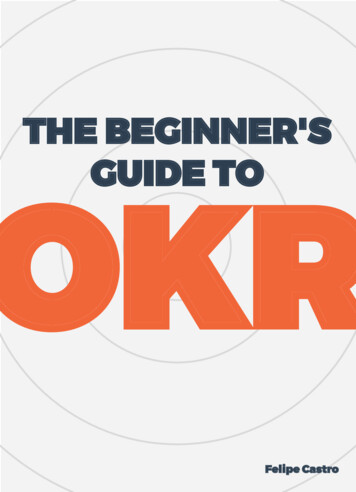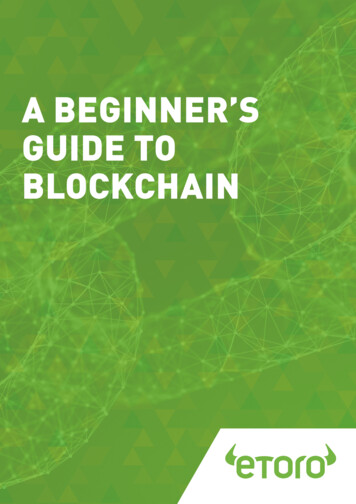
Transcription
A BEGINNER’SGUIDE TOBLOCKCHAIN02
ContentsIntroduction03 IntroductionCryptoassets, and particularly bitcoin or“digital gold” as some experts have labelled it,is a hot topic. Many believe they represent thefuture of money. Arguably, the most importantand exciting element in the crypto space is theunderlying blockchain technology.05 What is blockchain?07 How does blockchain work?09 Features & differences11 Is there more than one blockchain?13 Blockchain transforming industries15 GlossaryBlockchain technology will revolutionise the way weinteract with each other. It is a technological advancementthat could have wide-ranging reverberations that willnot only transform financial services but countless otherorganisations and industries, such as healthcare andsecurity. Why? Due to the way it allows information to betracked and stored in a trustworthy and transparent way.“This relationshipbetween blockchainand cryptoassets issimilar to the onebetween the internetand email.”Interest in crypto has grown with the rise of bitcoin,and the hundreds of other cryptoassets the originalcryptocurrency has spawned since it was launched in2009. In fact, the idea of a blockchain has been around foralmost 30 years, since the early 1990s. Bitcoin is simplythe first successful application of blockchain technology,which has become integral to the popularity of the everexpanding cryptoasset world.This relationship between blockchain and cryptoassets issimilar to the one between the internet and email. Muchlike email is just one use case of the internet, the firstcryptocurrency – namely, bitcoin – is the original use caseof blockchain technology.This guide refers to the bitcoin blockchain.0203
So what is blockchain?A blockchain is a secure, distributed database.For example, normally in an office all thecomputers are connected to one commonserver. However, with blockchain technology thecomputers are linked to many different devicesand processors. Within this database there isan ever-growing list of blocks. Upon entry, eachblock is time-stamped and ‘attached’ to theprevious block to create a ‘record’.“A good metaphorfor blockchain is ‘theinternet of value’.”A good metaphor for blockchain is ‘the internet of value’.Anyone can produce and publish information on the internetand others can access that content wherever they are inthe world. Likewise, a blockchain allows someone to sendvalue anywhere around the globe where the blockchaincan be accessed. It is crucial to have a public-private,cryptographically-created key pair in order to access theblocks you own.In summary, a blockchain is a shared, inflexible databasefor recording the history of all transactions using a systemthat encourages transparency and trust, minimising theneed for trust by distributing it across the network users.In the words of the father-and-son authors of BlockchainRevolution, Don and Alex Tapscott, a blockchain isdefined as an “incorruptible digital ledger of economictransactions that can be programmed to record not justfinancial transactions but virtually everything of value”.Perhaps the most impressive feature of blockchaintechnology is that it provides security in an unsecuredinternet – where phishing and malware can compromisethe data of individuals and jeopardise the way business isdone around the world.0405
How does blockchainwork?Blockchain securely stores data in batches – orblocks – that are linked together chronologically,forming a continuous chain. Unlike the old ledgermethod, whereby a book or database would beused to store information, the blockchain wasdesigned to be decentralised and distributedacross a large network of computers. Thisclever decentralising of data limits the abilityto tamper with the information, building trustin the system.In order to create this hash we have to start with thefilename of the document, for example, eToro2018,and see what hash it produces. For example, if thefilename ‘Crypto needn’t be cryptic’ created the hash0009ehk5lki6bnm7hgf2srt7fk9, we know it is incorrectas it doesn’t start with the correct number of zeros. Thisprocess is called “mining” and is done by trial and error.How is it tamper-proof? The way a block links with previousblocks, and then the next block appends itself to the chain,meaning it is impossible to change any information withoutimpacting the whole chain.“To add a block to theblockchain, a computermust provide a code or‘hash’ in order to createa batch of data thatforms the next block.”To add a block to the certain blockchains, a computer mustprovide a code or ‘hash’ in order to create a batch of datathat forms the next block. That computer will then share thesolution to all the other computers in the network, providinga ‘proof-of-work’. Once entered, the network will verify theproof-of-work and a block will be added to the chain.To find the hash, computers use a process of trial and errorto guess the cryptographic signature – a combination of therecord of the most recent crypto transactions along with aproof-of-work and the signature for the previous blocks.Once the combination has been found and verified by thenetwork, a new block is added to the blockchain. The racefor the next hash then begins. This is known as mining.Imagine each block is a Word document. And the filenameof that document is ‘Crypto needn’t be cryptic’. The fileneeds to become a “hash”, a sort of fingerprint for a fileor block. A hash is a combination of letters and numbersthat must start with a predetermined number of zeros(at the time of writing, it was 18 zeros), for 7
Features & differencesFor many, blockchain – rather than bitcoin andthe crypto stampede it triggered – is by far thebigger game-changing innovation introducedby Satoshi Nakamoto, the name given to theanonymous person (or persons) who publishedthe famous white paper, Bitcoin: A peer-to-peerelectronic cash system on 31 October 2008.This is because blockchain technology, which laid thefoundations on which a vast majority of cryptos nowoperate, has the potential to transform numerousindustries outside the crypto sphere. These includehealthcare, financial services, and housing, to name butthree. Experts are queuing up to proclaim its potential tobe as revolutionary as the internet.Cryptography – as mentioned above – ensures that thosewho use the blockchain can just edit the parts they effectively‘own’ by possessing the private keys needed to access theirrecord. This also means that everyone’s version of theblockchain is synchronised at all times.For example, MedicalChain is the first healthcare organisationto employ blockchain technology to facilitate the storage andutilisation of electronic health records to deliver a completetelemedicine experience. Only certain people can view theserecords and they cannot be edited.With an inbuilt safeguard against fraud and false identity,greater transparency,lower fees for cross-bordertransactions, and freedom from government interference,cryptos have started transforming payment systems aroundthe world.However with an electronic payment system, and ifmoney takes the form of a digital file, you may think thatit might be possible to replicate it. This is not the casewith the blockchain. The bitcoin blockchain securesthe cryptocurrency by making it impossible for it to becounterfeited.Let’s imagine George has a bike that he wishes to sellonline. Peter has viewed the bike and is keen to buy it.Rather than requiring a third party, such as PayPal, toprocess the transaction, bitcoin and other cryptoassetsthat use a peer-to-peer payment system can make itmuch more straightforward. Peter initiates a transactionby sending George the agreed amount of cryptos and,once processed, the bike is exchanged. If George then failsto give Peter the bike, the transaction will be reversed.“Blockchain has thepotential to transformnumerous industriesoutside the cryptosphere.”This is why blockchain technology is central to cryptos,and sets them apart from other currencies, by: Decentralising data and allowing information to be shared; Building trust in the data through peer-to-peer verification; Allowing people to interact with the data without the needfor an administrator or intermediary using cryptography.0809
Is there more thanone blockchain?Yes. Blockchain is a technology, and not a singlenetwork, meaning it can be implemented inmany different ways. Some blockchains arecompletely public, Bitcoin, for example, andopen for anyone to view, while others are onlyvisible to a select group of authorised usersand called a private blockchain in a network.The latter group is used by banks, governmentagencies, and similar.There is a third type: a hybrid blockchain, sometimescalled a federated blockchain. This is a fusion of the publicand private approaches, where some data is accessible toall with a fraction of it held back for the eyes of only a few.Certain members of a hybrid blockchain can determinewhat transactions remain public and what informationshould be confined to a smaller group, protecting digitalassets – the best of both chains, if you will.For instance, Lucy has a blockchain-backed digital medicalrecord. Every time-stamped entry is a block, meaningevery appointment Lucy attends is recorded. This showsLucy’s medical history, and is invaluable to a doctor who isin possession of the private key that allows him or her toaccess the data. As blockchain travels in one direction, bydesign it is impossible to alter the record retroactively. Theinformation is shared with a third party – such as a specialist– only when Lucy or the doctor allows it.football fans will be able to scan a barcode on an itemof merchandise and be reassured that it’s an officialproduct. Similarly, it could bring transparency to the saleand resale of tickets.In the food industry, OriginTrail allows consumers toknow where their purchases came from and how theywere produced. Tampering with sell-by dates and addingsecret ingredients cannot happen.When it comes to precious stones, as with food, blockchaincan help to build confidence by providing a completeand transparent record of providence. De Beers, whichmines, trades and markets more than 30 per cent of theworld’s supply of diamonds, has plans to use a blockchainledger for tracing its precious stones from the mine tothe customer purchase. This transparency will help theindustry as a whole and individuals in particular who wishto verify that the diamonds they are buying are free fromconflict.“Blockchain is atechnology, and not asingle network, meaningit can be implemented inmany different ways.”While blockchain’s original purpose was to powerbitcoin, society is now beginning to benefit from its manyapplications. For example, verifying the providence ofdiamonds, tracking contaminated food, or even payingthe dentist. How? By being transparent and digitallyaccessible to all.For example, when you buy a football shirt, how doyou know it’s a real one and not counterfeit? From themanufacturer to the club to the shop, you can keep recordon the blockchain. Since it’s immutable, you know thatnobody can edit it. It is possible that in the near future1011
Blockchain transformingindustriesWhen it comes to music, films and books, theadvent of the internet, and streaming sites suchas Soundcloud, Mixcloud, and Spotify, has madedigital music more accessible to everyone. Thiscomes at a cost to the artists, insofar as they arenot remunerated for physical sales of albums orsingles in the way they used to be. Blockchainhas the potential to put an end to that.In the same way bitcoin can make a token that cannot bereplicated, the Recording Industry Association of America(RIAA), for example, could sign every digital copy of a songto a single buyer. This applies for films and books, too, andwould return entertainment to the days when purchasing analbum, hardback novel, or DVD would mean exactly that.Moreover, Estonia – “the most advanced digital society inthe world”, according to Wired – began experimenting withblockchain technology in 2008, a year before it was usedto underpin bitcoin. It is used to help with the country’shealthcare database, and its voting system. All of whichcan be accessed digitally by any resident. In these daysof fake news and fears of election rigging, blockchaintechnology could be the answer.Elections require authentication of the identity of thosevoting, in addition to secure record keeping, and trustworthytallies to identify the election winner. Blockchain tools canbe used to ensure vote casting, tracking, and counting iscorrect and tamper-proof. Follow My Vote is one exampleof a blockchain voting startup. Using this, for example,Sally can vote with the reassurance that her decision ismade available on the blockchain for all to see, and cannotbe altered.blockchain could be even bigger than that. However, weare still at a very early stage of the technology’s life cycle,and that is crucial to bear in mind.“If you consider that the first elements of the internetwere put together as far back as the 1960s, and Hotmail,which launched in July 1996 and offered the world’s firstuser-friendly electronic-mail platform, I would suggestthat blockchain is currently at about 1994 – the year theworld’s first internet café [Cafe Cyberia in Whitfield Street,London] opened – by comparison: therefore, blockchain ison the cusp of mass-scale adoption.”“The Recording IndustryAssociation of America(RIAA), for example,could sign every digitalcopy of a song to asingle buyer.”Iqbal V. Gandham, UK Managing Director at eToro, ispositive blockchain technology will change the world forthe better. “Many experts predict that blockchain willbecome as revolutionary, transformative and important inour daily lives as the internet is today,” he says. “I believe1213
GlossaryBitcoinThe first and largest cryptocurrency (by market cap). Bitcoinwas launched in 2009 as a decentralised currency, built onblockchain technology. It’s the first real-world applicationof blockchain. Bitcoin was created by a person (or group ofpeople) under the pseudonym Satoshi Nakamoto.BlockchainA decentralised network, built from a continuous chainof blocks. All transactions on the network are stored ona public ledger, which exists throughout the network,meaning there is no need for a central server to authorisetransactions.CryptocurrencyA digital currency that uses cryptography to verifytransactions and provide security. The first major applicationof blockchain, a cryptocurrency is a currency designed tohave no central ownership. Blockchain technology is theinfrastructure that enables cryptocurrencies to be storedon the network to change hands.CryptoassetAn umbrella term used to describe cryptocurrencies,tokens, cryptocollectibles, and crypto fiat currencies.Private keyA string of numbers and letters known only to the user.Each user on the network holds a private key. It equates toa ‘password’.Public keyA string of number and letters that is used to encrypt dataon the blockchain. If the private key can be equated to apassword, the public key is a username of sorts, as it isavailable for all to see on the public ledger.This guide is provided for information and educational purposes only and should not be considered to be investment advice or a recommendation.The information and opinions contained in this guide are based on sources believed by eToro to be reliable.No guarantees or warranties are madeto its accuracy, completeness or suitability for any purpose. Cryptocurrencies can widely fluctuate in prices and are not appropriate for all investors.Trading cryptocurrencies is not supervised by any EU regulatory framework.1415
02
cryptocurrency – namely, bitcoin – is the original use case . the best of both chains, if you will. For instance, Lucy has a blockchain-backed digital medical . films and books, the advent of the internet, and streaming site
